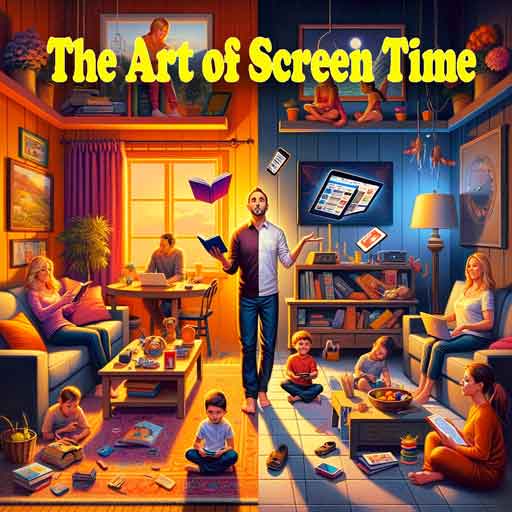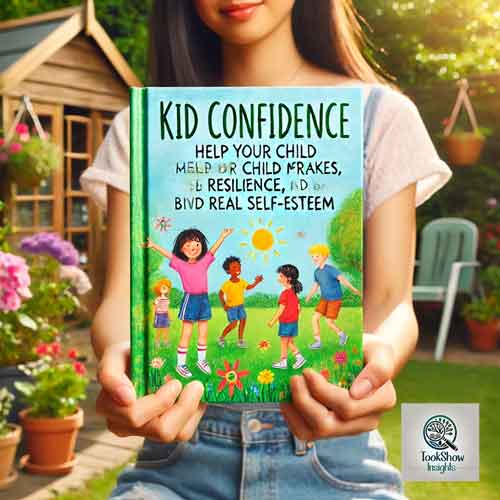The Art of Screen Time: How Your Family Can Balance Digital Media and Real Life Book Summary

“Digital Parenting and the Art of Screen Time” are central themes in “The Art of Screen Time: How Your Family Can Balance Digital Media and Real Life” by Anya Kamenetz. This comprehensive guide delves into the challenges that parents face in today’s advanced technological era.
The book emphasizes the importance of digital parenting in achieving a balance between family life and immersion in the digital world of screens. It shines a light on how digital media impacts children and families as a whole, offering realistic strategies for managing this influence. The book discusses the art of screen time in a way that prompts readers to rethink their digital habits and explore new methods to make technology serve the family’s interests, rather than the opposite.
Through this work, Kamenetz provides a balanced and practical view of digital parenting, illustrating how parents can guide their children towards healthy and beneficial use of technology. It’s an invitation for families to consciously interact and engage in the digital world, making it an indispensable resource for anyone striving to achieve balance in our modern digital age.
Table of Contents
Embracing Screen Time in the Digital Era: Insights from “The Art of Screen Time” by Anya Kamenetz
In the pivotal book “The Art of Screen Time: How Your Family Can Balance Digital Media and Real Life,” author Anya Kamenetz begins by demystifying the concept of screen time in our modern era. This initial exploration is crucial, as it lays the groundwork for understanding how deeply intertwined digital media is with our daily lives. Kamenetz doesn’t approach screen time as a mere numerical value of hours spent in front of screens; instead, she delves into its qualitative aspects and how it’s woven into the fabric of contemporary living.
The book opens by acknowledging that screen time is no longer a simple matter of leisure or entertainment. In today’s world, screens are a multifaceted presence, serving as gateways to education, work, social interaction, and information. Kamenetz paints a vivid picture of this new reality, where digital devices are integral to our daily routines, from young children participating in e-learning to adults telecommuting for work.
What sets Kamenetz’s approach apart is her refusal to demonize screen time. She recognizes its necessity and ubiquity but also stresses the importance of conscious and mindful engagement with digital media. The book shares stories and examples where screen time facilitates connection, learning, and even creativity, breaking the stereotype of it being solely a passive or detrimental activity.
Kamenetz’s narrative is interspersed with real-life scenarios that many families will find relatable. For instance, she discusses the story of a family navigating their children’s online education during the pandemic. This example illustrates the dual nature of screen time: as a lifeline for maintaining educational continuity, yet also a source of concern for parents wary of excessive exposure.
The book’s exploration of screen time in the modern context is a blend of acknowledgment and caution. It’s an invitation to embrace the digital age’s offerings while remaining vigilant about the potential pitfalls. Kamenetz doesn’t offer a one-size-fits-all solution but encourages readers to find a balance that aligns with their family’s values and lifestyle.
In essence, “The Art of Screen Time” shifts the dialogue from how much screen time is too much, to how we can make screen time work for us in a balanced, healthy way. Kamenetz’s insightful and humane approach in this book is a valuable guide for anyone looking to navigate the complex digital landscape with confidence and positivity.
Navigating the Digital Divide: A Deep Dive into “The Art of Screen Time” by Anya Kamenetz
In her enlightening book “The Art of Screen Time: How Your Family Can Balance Digital Media and Real Life,” Anya Kamenetz tackles a crucial issue facing modern families: balancing digital and real-life interactions. This part of the book is particularly resonant as it addresses a common struggle in today’s tech-driven world – finding harmony between online and offline lives.
Kamenetz begins by acknowledging the integral role digital media plays in our lives. It’s not just about leisure or entertainment; digital platforms are essential for education, work, and social connections. However, she brings to light the equally vital need for quality time away from screens. This balance, Kamenetz argues, is key to maintaining healthy relationships and personal well-being.
The author introduces us to various families, each dealing with their unique digital dilemmas. For instance, one story involves a family where parents and children are absorbed in their devices, leading to a lack of meaningful communication. Kamenetz uses these relatable scenarios to illustrate the potential pitfalls of unbalanced screen time and the importance of setting boundaries.
She doesn’t advocate for a complete digital detox. Instead, Kamenetz emphasizes a more practical and sustainable approach. She suggests designating tech-free zones and times in the house, encouraging activities that involve personal interaction, like family game nights or outdoor adventures. This approach not only reduces screen time but also strengthens family bonds.
Kamenetz also touches on the role of parents as role models. She points out that children often mimic their parents’ digital habits. Thus, she urges parents to lead by example, demonstrating a healthy balance between digital engagement and real-life presence.
In essence, “The Art of Screen Time” doesn’t just present the challenge; it offers a roadmap to navigate this complex digital landscape. Kamenetz’s insights are a blend of practical advice, real-life examples, and research, making this book a vital guide for families striving to find their equilibrium in a digitally dominated world. Her message is clear: balance is not about elimination, but about integration and mindful engagement with our digital and real lives.
The Digital Childhood: Unraveling the Impact of Media on Kids in “The Art of Screen Time”
Anya Kamenetz’s “The Art of Screen Time: How Your Family Can Balance Digital Media and Real Life” offers a profound insight into how digital media affects the development of children, covering emotional, cognitive, and social aspects. This section of the book is particularly compelling as it addresses a concern that is paramount to every parent and educator in the digital age.
Kamenetz begins by exploring the emotional impact of digital media on children. She delves into how excessive screen time can lead to issues such as decreased attention spans and potential emotional dysregulation. However, she also points out the positive emotional outcomes when digital media is used appropriately, such as the joy and satisfaction children experience when engaging in creative digital activities or connecting with loved ones online.
On the cognitive front, Kamenetz presents a balanced view. She acknowledges that certain types of screen activities can enhance cognitive skills like problem-solving and critical thinking. Yet, she warns against the pitfalls of unregulated screen time, which can impede academic performance and reduce opportunities for imaginative play and creativity.
Socially, the book addresses the double-edged sword of digital media. On one hand, it offers children unprecedented opportunities for socialization, learning, and exploration. On the other hand, Kamenetz cautions about the risks of reduced face-to-face interactions and potential exposure to inappropriate content or cyberbullying.
One of the most engaging parts of this section includes real-life anecdotes and studies. For instance, Kamenetz refers to research indicating that moderated use of digital media can be beneficial, fostering social connections and learning. She contrasts this with stories of families struggling to manage their children’s screen time, leading to social isolation or disrupted family dynamics.
Kamenetz doesn’t just highlight the problems; she offers solutions and guidelines. She emphasizes the importance of setting boundaries, choosing quality content, and ensuring that digital media usage is balanced with other activities. This approach helps parents navigate the complex digital landscape, ensuring their children reap the benefits of digital media while minimizing its risks.
In summary, “The Art of Screen Time” provides a comprehensive, nuanced perspective on the impact of digital media on children’s development. Kamenetz’s insights are invaluable for parents and educators striving to understand and optimize the role of digital media in children’s lives. Her book is a roadmap to harnessing the power of digital media positively, ensuring a balanced, healthy digital upbringing.
Fostering Digital Wisdom: Parental Roles in Guiding Screen Time from “The Art of Screen Time”
Anya Kamenetz’s “The Art of Screen Time: How Your Family Can Balance Digital Media and Real Life” provides a nuanced approach to parental involvement in managing children’s digital consumption. This section of the book, focusing on the role of parents, emphasizes not just the importance of involvement but the method of it – advocating for guidance over strict control.
Kamenetz challenges the traditional notion of imposing rigid screen time limits. Instead, she suggests a more interactive approach where parents engage with their children’s digital world. This engagement includes understanding the content they are consuming, discussing it, and even participating in digital activities together. By doing so, parents can better comprehend the appeal and risks of digital media and provide more informed guidance.
One compelling example in the book is the story of a family where parents decided to play video games with their children. This experience not only gave the parents insight into why their children were so captivated by these games but also opened up new avenues for conversation and connection. It shifted the dynamic from enforcement to understanding and collaboration.
Kamenetz also emphasizes the importance of being a role model. She discusses how parents’ digital habits are closely observed and often mimicked by their children. This realization encourages parents to reflect on their own digital practices and set a healthy example of balanced screen use.
Moreover, the book discusses the importance of creating a family media plan. This plan is not about strict rules but about setting shared goals and values around digital media use. It includes negotiating screen time limits, choosing appropriate content, and designating screen-free times and zones in the household.
In “The Art of Screen Time”, Kamenetz’s message is clear: parental involvement in digital consumption should be adaptive, empathetic, and informed. Her approach moves away from the binary of screen time being good or bad, focusing instead on how to make digital media consumption a constructive part of family life. This section of the book is a vital resource for parents seeking to guide their children through the digital landscape with understanding and wisdom.
Crafting a Harmonious Digital Environment: Family Media Planning from “The Art of Screen Time”
In “The Art of Screen Time: How Your Family Can Balance Digital Media and Real Life,” author Anya Kamenetz offers invaluable guidance on creating a family media plan. This aspect of the book stands out as it provides practical strategies for families striving to set healthy boundaries and expectations around screen use.
Kamenetz emphasizes the importance of a collaborative approach in developing a family media plan. She suggests that the process should involve all family members, including children, to ensure that everyone’s needs and concerns are addressed. This inclusive approach not only empowers children but
also promotes understanding and respect for the established guidelines.
The book provides detailed steps to create an effective media plan. One of the key recommendations is to start with a family meeting. Here, Kamenetz advises discussing each family member’s digital habits and preferences, and the role of digital devices in their lives. This meeting serves as a platform for open communication, where each member can express their views and concerns.
Kamenetz highlights the importance of setting clear and realistic boundaries for screen time. These boundaries can include designated screen-free times, such as during family meals or before bedtime, and specific areas in the home where screens are not allowed, like bedrooms. She also encourages families to consider the quality of screen time, focusing on educational or creative content that aligns with the family’s values.
Another critical aspect covered in the book is the need for flexibility. Kamenetz acknowledges that a family media plan is not a one-size-fits-all solution and should be adaptable to the changing needs and circumstances of the family. For example, the plan might be adjusted during school holidays, special events, or when new digital media trends emerge.
The book also includes real-life examples and stories from families who have implemented media plans. These stories provide insights into the challenges and successes that families may encounter in this process. Kamenetz uses these examples to demonstrate how a well-thought-out media plan can positively impact family dynamics, reducing conflicts over screen time and enhancing quality family interactions.
In summary, “The Art of Screen Time” offers a comprehensive guide to creating a family media plan. Kamenetz’s approach is practical, inclusive, and adaptable, making it an essential resource for families navigating the complexities of digital media use. Her advice helps families to not only manage screen time effectively but also to use digital media to strengthen family bonds and foster a harmonious digital environment.
Navigating Age-Appropriate Digital Content: Insights from “The Art of Screen Time”
In “The Art of Screen Time: How Your Family Can Balance Digital Media and Real Life,” author Anya Kamenetz delves into the crucial topic of selecting age-appropriate digital content and managing screen time for children at different developmental stages. This section of the book is particularly invaluable for parents and guardians seeking guidance on how to make informed choices about the digital media their children consume.
Kamenetz starts by highlighting the diversity of digital content available and how its impact can vary significantly depending on a child’s age and developmental stage. She underscores the importance of parents being actively involved in understanding and selecting the content their children are exposed to.
The book provides practical advice on how to assess digital content. Kamenetz encourages parents to look beyond age ratings and consider the educational value, entertainment quality, and the potential for promoting creativity and problem-solving skills. She also discusses the significance of content that reflects diversity and fosters empathy and understanding.
One of the key aspects Kamenetz explores is the balance between educational and purely entertainment content. She notes that while entertainment content has its place, it’s vital to ensure a healthy mix, with a stronger emphasis on educational material, especially for younger children.
Kamenetz includes real-life examples from families who have navigated these choices. For instance, she shares a story about a family who carefully selects apps and games that align with their child’s interests and educational needs, turning screen time into a valuable learning experience.
Furthermore, the book addresses the challenge of screen time limits. Kamenetz suggests that instead of strict time limits, parents should focus on the quality of screen time and its integration into the child’s overall daily activities. She emphasizes that screen time should complement, not replace, other essential activities like physical play, reading, and family interaction.
In summary, “The Art of Screen Time” offers a thoughtful and comprehensive approach to managing children’s digital consumption. Kamenetz provides parents with the tools to assess digital content, ensuring it is appropriate, beneficial, and balanced for their child’s age and development. Her insights guide families in creating a healthy digital environment that supports children’s growth and learning.
Guiding Families Through the Digital Maze: Lessons from “The Art of Screen Time”
In “The Art of Screen Time: How Your Family Can Balance Digital Media and Real Life,” author Anya Kamenetz offers a comprehensive guide for parents to navigate the complex and ever-evolving digital landscape. This part of the book is particularly relevant as it addresses the challenges parents face with social media, gaming, and educational content in the digital realm.
Kamenetz begins by acknowledging the overwhelming nature of the digital world. She understands that parents often feel out of depth with the rapid pace of technological change and the sheer volume of digital content available. The book provides a roadmap for parents to not only understand but also to confidently manage their family’s digital interactions.
One of the key areas Kamenetz focuses on is social media. She offers insights into how social media platforms work and their impact on children and teenagers. The book discusses strategies for monitoring and guiding children’s social media use, emphasizing the importance of open communication and setting clear boundaries.
Regarding gaming, Kamenetz explores the world of video games, demystifying common misconceptions. She highlights the potential benefits of gaming, such as problem-solving skills and creativity, while also addressing concerns like addiction and exposure to inappropriate content. The book provides practical tips for parents to choose age-appropriate games and set limits on gaming time.
Educational content in the digital space is another significant focus. Kamenetz sheds light on how to identify high-quality educational resources online. She advises parents to look for interactive and engaging content that supplements children’s learning while also encouraging critical thinking and curiosity.
Kamenetz also incorporates real-life stories and examples from families who have navigated these digital challenges. These anecdotes offer relatable scenarios and solutions, demonstrating how families can effectively manage and benefit from digital media.
In summary, “The Art of Screen Time” equips parents with the knowledge and tools to guide their children through the digital world. Kamenetz’s approach is balanced, informed, and practical, making it an essential resource for parents seeking to foster a healthy digital environment for their family. Her insights help parents to make informed decisions about social media, gaming, and educational content, ensuring a positive and balanced digital experience for their children.
Harnessing Technology for Education and Creativity: Insights from “The Art of Screen Time”
In “The Art of Screen Time: How Your Family Can Balance Digital Media and Real Life,” author Anya Kamenetz explores the positive aspects of technology, particularly its role as a tool for learning and fostering creativity in children. This section of the book is crucial for parents and educators looking to harness technology’s potential in a constructive manner.
Kamenetz challenges the common notion that technology
is merely a distraction or a negative influence on children. Instead, she presents a balanced perspective, highlighting how technology, when used thoughtfully, can be a powerful educational and creative tool. The book provides examples and strategies on how technology can enhance learning experiences and stimulate creativity in children.
One of the key points Kamenetz makes is about the interactive nature of many digital tools and how they can create engaging, immersive learning environments. She cites examples of educational apps and games that combine learning with play, making education a more dynamic and enjoyable experience for children.
Kamenetz also delves into the world of digital creativity. She discusses how technology opens up new avenues for creative expression, from digital art and music creation to coding and
designing. By giving children access to these tools, they can explore and develop their creative talents in ways that were not possible before. The book includes stories of children who used technology to embark on creative projects, showcasing the potential of digital tools to inspire and enhance creativity.
Furthermore, Kamenetz addresses the role of parents and educators in guiding children’s use of technology for learning and creativity. She emphasizes the importance of setting boundaries, choosing the right tools, and actively engaging with children as they use technology. This approach helps ensure that children’s screen time is not only about consumption but also about creation and learning.
The book also discusses the importance of balancing technology use with other activities. Kamenetz advocates for a holistic approach where technology complements traditional forms of learning and creativity, such as reading books, playing outdoors, and hands-on crafting.
In summary, “The Art of Screen Time” offers a refreshing perspective on the use of technology in children’s education and creative development. Kamenetz’s insights provide valuable guidance for parents and educators on how to integrate technology into children’s lives in a way that promotes learning, creativity, and overall development.






